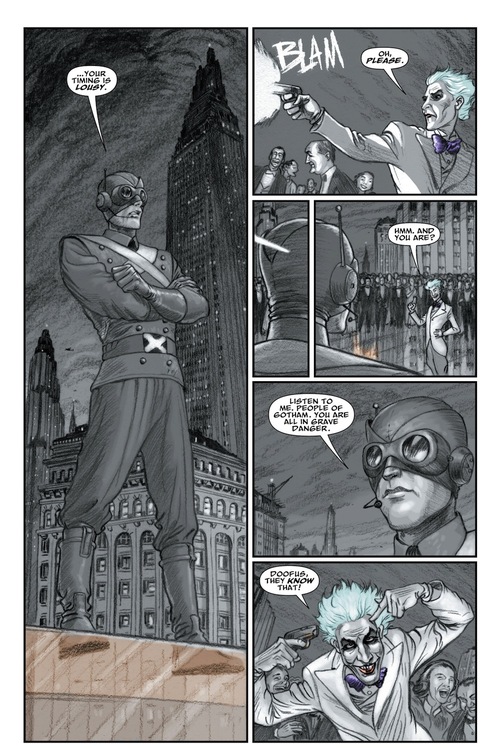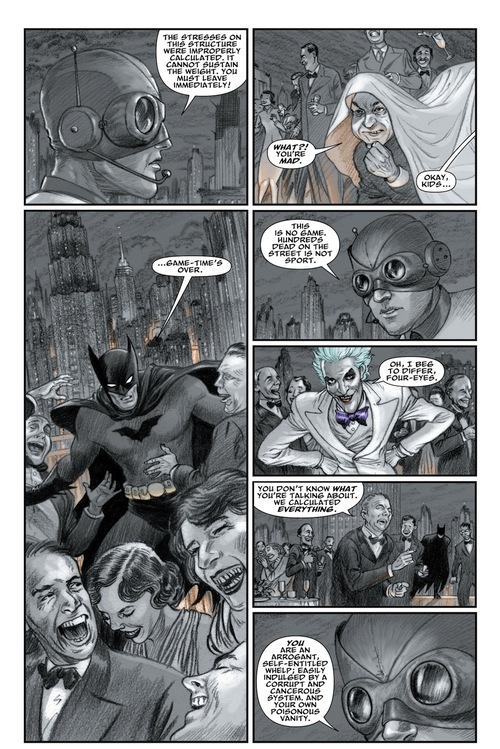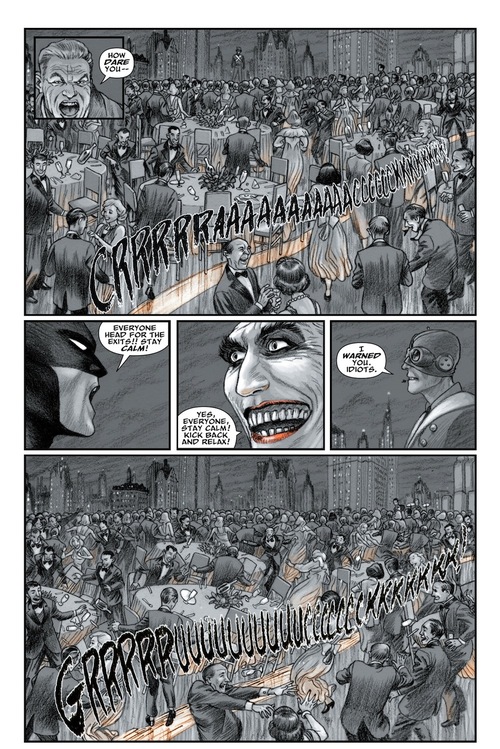A truncated version of this piece first appeared on The Huffington Post…
Chip Kidd, the legendary author and designer, is the writer behind a new Batman graphic novel called Death by Design. It’s a very smart and brilliantly illustrated black-and-white film turned comic book that tells a story of a Gotham crumbling at the foundations by corruption. I can’t begin to explain how much I loved the book, reading it I felt like I was in an old one-room movie palace, watching a lost Carol Reed/Orson Welles collaboration. But when I’d look around, I’d still just be on my couch reading a comic book.
Kidd and illustrator Dave Taylor blended the comic medium and it’s most popular character with all the aesthetic of a World’s Fair that rocketed this near the top of my favorite Batman books. Some might dismiss it as being boring or not action-packed enough, but my guess is that none of those people have ever seen Casablanca either.
I had a chance to speak with Chip Kidd about the project and our conversation is transcribed below. Further down, you’ll see an exclusive sneak peek of the book. If you’re a fan of both Batman and classic noir cinema, this book is a must read.
Bryan Young: I’d like to start on what sparked your connection to the Batman, right off the bat.
Chip Kidd: It’s just something I’ve sort of been obsessed with ever since I was about two years old. I was born in 1964, the TV show debuted in sixty-six, and I kind of got hooked from there. I don’t know. There was just something about the character and also the design of the character that really interested me, and I think struck some kind of emotional chord.
BY: So from the sixties’ show, did that drive you to the comic then?
CK: Yeah exactly. And there was a bazillion toys too.
BY: I hear you’ve got quite the collection of the bazillion toys.
CK: Ha! Yeah.
BY: One of the questions I was curious about, since you’ve sort of been driven to the comic way earlier than probably anybody I’ve ever talked to, what have been the arcs through the years that have really influenced your take on Batman?
CK: There was an arc in the seventies by a writer name Steve Englehart and an artist named Marshall Rogers. And actually, the anchoring villain to the whole thing was this character named Hugo Strange. Which is like, from Batman number one, in the forties.
And it’s a really brilliant run in Detective Comics that included the Joker with the Laughing Fish. And there was this really really great, I think one thing that Batman, they’ve tried to give him a Lois Lane for almost since the beginning. You know, Vicky Vale sort of came and went. You know like a really good civilian female foil for Bruce Wayne basically. So Englehart and Rogers created this woman named Silver St. Cloud. In some sense, my character Cyndia Sill was inspired by her, in that she is like a really strong, purposeful character. She’s not just a damsel in distress.
BY: Reading the book, it feels like you are watching a movie. It’s very cinematic. It has this sort-of heavy noir influence. It’s almost a little bit surprising to hear that your influences, or your inspiration, what got you into Batman is more sixties, seventies Batman. It feels much more much more forties. At least with reading this book.
CK: Well, I would hope so. My fandom and this particular project are not two separate things, but this book is its own thing. And I really very much wanted it to feel like a really good film from the thirties actually, from like the late thirties. And the art direction to the artist, Dave Taylor, was what if Fritz Lang had a big budget to make a Batman film in 1938? What would it look like? We never specifically say what year it is, but it very much meant to feel like it’s set back then.
BY: I can definitely see that with the glass floored club, and things like that, it’s very sort of over the top. And I can actually see it in that black and white sort of tone. What sort of cinematic influence was there for you? I know reading about Orson Wells working on Citizen Kane, he was going back and looking at Stagecoach for inspiration. This feels so rich, but there’s nothing you can put your finger on it; there’s Hitchcock, there’s Grace Kelly, like you said there’s Fritz Lang, definitely Fritz Lang. Where else were you coming from on that? And have it be so unique…
CK: Well, that’s great! Unique is good. We like that. I would say also The Fountainhead, both the novel and the film, for all the architectural stuff and then On the Waterfront for all the crooked union stuff. And all of those are black and white. I think all of those influences went into it visually. For a writer I was given a lot of say into the art direction of the book. I think that is pretty unusual.
BY: It was amazing, as I was researching you, I astounded to find out how many books I own that had crossed your desk initially, from Conversations with Woody Allen to David Sedaris, or even Jurassic Park. Being sort of a designer of that caliber, with a very discerning eye, what was the processes like working with David Taylor?
CK: It was great. It was great because he was really amenable to collaborating in a way. I feel like I can do everything but draw. And I can see things in my head and know what they should look like, but I’m simply not a very good draftsman. Which is frankly why I became a graphic designer and an art director. He was great to work with. My scripts were very diagramed out. They weren’t just like a movie script, which a lot of comic book scripts are. There are a zillion different ways to do this. I would break the pages down into panels and say this is what’s happening in this one, and this is what’s happening in this one. But there were times that he would deviate and always for an excellent reason, and he was always right.
BY: From a designer’s stand point what is it that you think is so alluring about Gotham?
CK: Well, we were hoping to capture that in the book. You know by this point there are so many different versions of everything. It’s been seventy years and the character is so popular and all of these different types of mediums. You know there’s the take on Gotham that is like what if New York had no zoning code, and everything was completely over the top. There’s the whole it’s very much actually like New York. I was going for, well one of the other heavy visual heavy influences was an architectural renderer named Hugh Ferris, as in the Ferris Wheel, although he didn’t design the Ferris Wheel, he was the sort of visual architectural renderer from the first three decades of the twentieth century who with just pencil and charcoal would draw these, kind of urban utopian monolithic buildings. So that was also very much an influence on how it would look. I wanted it to look like a place that you would very much want to live, but then they do something like they build the ceiling and then it falls apart.
BY: It’s got this World’s Fair quality to it almost.
CK: Yes. I love that.
BY: In the last year or so it seems like architecture and the history of architecture in Gotham have come more into the forefront with Scott Snyder’s Gates of Gotham and all the stuff he’s doing. It seems like we’ve always heard of Gotham as sort a character, but why do you think it seems like now is that time, why is it… I’m not sure if I’m explain what I’m trying to say properly.
CK: It’s alright. I think that anything about Gotham is also about New York. And I think certainly in that ten years, New York as an urban environment, has been the focus of the world or a heavy focus of the world, where you have this horrible horrible thing happen and everybody was sharply focused on the city, and how it would react and rebuild itself. And I don’t think that’s really stopped. So in a sense, the in the comics, Gotham is the same way. It can become a sort of projection of what we hope for in an urban environment or what we are afraid of in an urban environment, and what would need to happen to fix it.
BY: You’ve got a very striking story there. That there are these amazing gems of architecture, landmarks that are literally crumbling before our very eyes because of the foundation of graft and corruption that they are built on. Do you think that is a reflection of what is going on in New York, right now, or in the past?
CK: I think thankfully more in the past, but look, there was another crane collapse last month that killed that guy. That killed one of the construction works. In that sense, it’s still pretty bad. You have the union thing, we’re not going to accept these inspection regulations that you’re imposing on us. We’re just not going to accept them. You know, it’s just incredible. Now, in terms of buildings themselves, no. I mean, I’m literally sitting right now in my office looking at a skyscraper that’s going up across the street and that’s been amazing to see. And in my old office I watched the Hearst building get built. And that was an amazing thing to see. I think once they commit to building the buildings, the buildings themselves are fine. But you know, again with these crane collapses, it’s remarkable.
BY: There are a lot of different Batman audiences right now. You’ve got audiences that ranges from my son who’s nine years old and he likes the cartoons to sort of the more savvy audiences, to the audiences who like to see Batman just beat stuff up. What compelled you to feel like this was the right sort of story for Batman and this flavor of Batman?
CK: I thought this particular story had not been told before. When I was asked to do this, I tried to think of, “Well what will people think that I’m good at that I can bring to it?” So then it sort of grew out of there.
BY: I read a story where you were talking at a conference to designers about Penn Station and some of these crane collapses and sort of connected the dots in your head. Was that accurately reported?
CK: Yes, yes that was accurately reported. That’s why very much a fiction. I was thinking about, “What if this happened in Gotham in the thirties and what if these two events somehow were related?” And what it all comes down to, as you said, corruption and graft. I think anybody who wants to tell any kind of Batman story, and do it well, has to ask themselves, “So why does this character exist? Why does Batman exist?” And the answer is Batman works best when Gotham City is a mess. And somebody that can go beyond the powers of Bruce Wayne can do something about it.
What I very much like about the character, is that the two alter egos meet each other. Obviously Batman came about because there were certain things that he could do that Bruce Wayne can’t, but it goes the other way. Bruce Wayne can save a building, especially one that was built by his father and that he owns. I tried to make them two very strong characters that are very much comfortable with each other. As opposed to agonizing over whether he should exist or not, or one should give over to the other one completely. You know that’s an interesting theme too.
It’s just not one that I was interested in exploring.
BY: Another thing that I noticed through the book, especially through the character of
the architect’s son, who’s got this sort of space-age device that lets him appear in
places, and it felt very much like one of those old thirties cereals. It had that quality to it that you were treating it with a reverence that made it feel like if Orson Wells had done this we’d have totally bought it.
CK: Well, that’s a very high complement. That’s the kind of thing I was aiming for. Something that felt fun and lively, but that had a weight to it.
BY: It definitely did. As I read the book, I felt, I really was, I kept coming back to Orson Wells, to post war Vienna and The Third Man, which I know is Carol Reed, but Orson Wells was there. It felt like that unraveling mystery, that damsel. I really did enjoy the book.
CK: Well thank you, very much. That’s very high praise. He’s the best, or one of the best, certainly.
BY: Yeah, definitely. It was great to see it embodied in Batman. I’m not sure if you read Tom Hiddleston’s editorial in The Guardian. He was Loki in The Avengers, and he was talking about how people shouldn’t dismiss super-hero stories, they can be high art or of a literary caliber. I think that this is one of those stories certainly you can take, classic story telling, and put him in dressed as a flying mouse, in it, and it still works. I don’t know if you can comment on that at all.
CK: Well, obviously I agree. I think these characters are great constructs to hang an effective story on. And I think the genre of comics sometimes over takes the medium, and people assume that they are kind of frivolous. If you have a good strong story teller, they can be they can be as affecting as any character in literature. Period.
BY: And then my last question for you is, what is it that you like about telling a story in this way? Are you going to be doing more story telling in the graphic format as opposed to your day job as a legendary designer?
CK: That part remains to be seen. I would love to do more. It’s funny. I’m very much a wait-to-be-asked kind of guy. And they literally asked me to do this. Which is insane. I would like to do more. I think there all sorts of things that are unique to the graphic novel format from, “O.K. let’s cast Grace Kelly as our lead.” to you know something very interesting when you turn a page or go from a panel to a panel. Yes, I certainly hope to do more.
Batman: Death by Design comes out June 5, 2012.
Bryan Young is the editor of the geek news and review site Big Shiny Robot! and author of the just released pulp sci-fi adventure Operation: Montauk.



